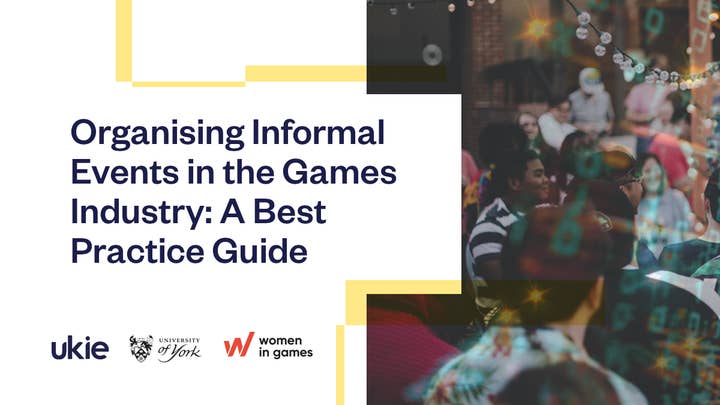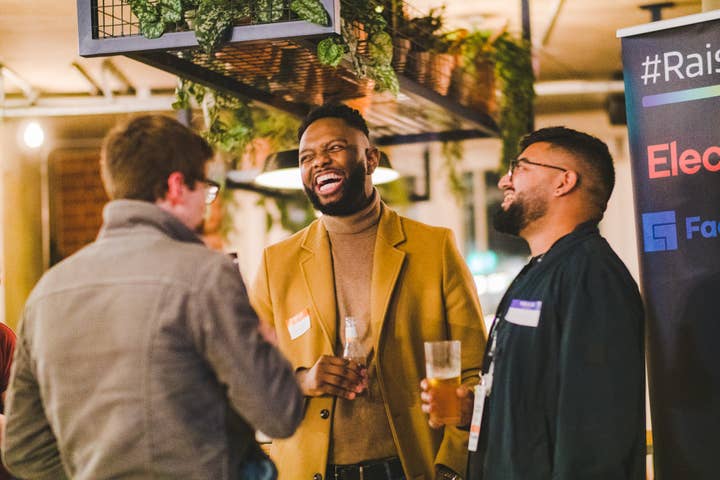Seven steps to organising an inclusive games industry event
A practical guide for thinking about the best way to create inclusive events across the industry
New research from Ukie and the University of York, backed by Women In Games, has found that informal learning and networking events such as game jams, conferences, workshops, meetups and practical courses are a vital part of career development and industry expansion.
But sometimes these events can directly or indirectly exclude those from marginalised backgrounds due to factors like cost, timing, geographical location, the behaviour of organisers or participants and venue accessibility.
What steps can event organisers take to ensure that events are truly inclusive? We've produced an abridged version of our best practice guide to give you advice to do just that.
- 1. Build an inclusive team
- 2. Define the purpose of your event and your audience
- 3. Consider the time of your event
- 4. Consider geographical location and access
- 5. Plan for accessible materials and content delivery as well as attendee comfort
- 6. Create a robust code of conduct
- 7. Provide room for feedback and accountability

1. Build an inclusive team
The organisational team of an event is important for ensuring greater inclusivity and diversity in the industry, partly because the organisation of events requires the team to contribute significant emotional labour to ensure that events are successful.
- Reflect on the demographics of your own organisational team; inclusion and diversity begins here, which in turn brings new voices, experiences and networks to the process of creating inclusive events.
- If possible, compensate your staff members for their work. If not possible, consider other ways to recognise their efforts.
- If appropriate, your team should have the opportunity to access resources and training to facilitate their work.
Inviting diverse speakers and collaborators to your events also plays a significant role in your communities to demonstrate a variety of experiences, job roles and career trajectories.
- Allocate sufficient time to contact potential speakers and collaborators. Consider that people with different lived experiences have different capacities to attend events. Therefore, discuss how you could facilitate speakers' participation -- for example, providing flexible forms of participation (e.g. online).
- Depending on the size of your organization and available budget, offer compensation for speakers' participation in your event and be transparent about your financial possibilities.
Reflect on the demographics of your own organisational team; inclusion and diversity begins here
- Be transparent about how the speakers' content should be delivered and what will happen with the content. Some speakers may not wish for their presentations to be distributed online (e.g. through social media) or discussed online.
- Remember to reach out beyond established networks to people who would be excellent collaborators by operating outside of your connections, eg. by using social media channels popular within the games industry.
- Don't be afraid to invite new people (e.g., entry-level collaborators) as speakers to your events. Engaging new people in presenting their ideas allows you to expand your networks and train new talent in the industry.
- You should also reflect on how you can support talent development by preparing resources for people who want to develop their public speaking skills for industry events.
Organisers, speakers and collaborators are the foundation of building an inclusive event.
2. Define the purpose of your event and your audience
Clearly defining the audience of your event plays a crucial role in establishing rules of participation and in attracting a wider pool of participants who will benefit from the event.
However, in thinking about inclusivity and diversity, it is important to transparently state for whom the event space exists, and include this in any promotional materials.
- Clarify for whom the event is being organised. Is your event organised for a specific marginalised group? Is it more open to participation from other groups?
- If you plan to organise an event to include a specific marginalised group, directly consult this group regarding your event theme, activities, use of language and venue choices.
- Defining the structure of the event and the proposed activities will also provide greater clarity for prospective audiences.
- Problems with discoverability of the events can hinder attendance. Promote your event outside of known networks. This also expands outreach to people who might be interested in a career change, therefore expanding interest in the industry.
The time of an event (both the time of the day and duration) significantly impacts prospective attendees' decisions to attend
3. Consider the time of your event
The time of an event, in terms of both the time of the day and its duration, significantly impacts prospective attendees' decisions to attend the event. Reflect on what kind of time and duration of the event would be the most suitable for your audience, and consider the following:
- Time of day
Offer alternatives to late -- night networking events, such as lunchtime events, afternoon networking events and brunch events.
- Duration of the event
Adjust the duration of the event to meet the needs of prospective attendees. For example, intensive weekend -- long workshops could prevent attendees with parental and caring responsibilities from attending.
- Flexibility of participation
Time pressure related to certain events might also make them less inclusive. Building flexibility (e.g. in joining and leaving the events) is important to encourage attendees with different lived experiences to attend.
If possible, the attendees should also be able to attend the events online or in 'hybrid' mode (ie. Some attendees attend online and some in -- person) to remove some of the time pressures associated with the events.
Taking these factors into account will help to remove barriers to participation that affect the accessibility of learning and networking events.

4. Consider geographical location and access
In the UK the games industry is more geographically dispersed than other cultural industries, which tend to be more clustered in London and the south-east of England.
The geographical location of the event raises issues about access to events, their discoverability and costs of attending. To address these barriers, you can reflect on the following:
- Information and transparency
Promote the event well in advance to allow potential attendees to organise their participation accordingly.
Provide detailed information about transportation (and its accessibility) to the event and venue.
If applicable to your event, provide detailed information about accommodation and dining options, and consider their different levels of affordability.
The geographical location of the event raises issues about access to events, their discoverability and costs of attending
- Alleviate the cost of participation
If possible, provide bursaries to alleviate the costs of attending the event. Participation in the event is more than a cost of entry fee and often includes transport, accommodation and additional costs, such as the cost of home childcare if not possible to attend with children.
- Think about alternatives
Offer alternative forms of participation -- for example, through joining the event through livestreaming, access to some of the event's materials online post -- event and/or designated forums to foster networking.
Reflect on the possibility of expanding your events to different cities and regions. This might be possible through establishing partnerships with other organisations. The creation of a more inclusive, accessible environment for the events is also defined by the spaces in which the events take place -- both in terms of online and offline environments.
Provide detailed information about the venue in terms of the following:
- Accessibility to the venue and transport links.
- Information about the layout of the event space so your attendees do not have a problem accessing and moving around the space.
- Determine the capacity of the space, ie. the number of seats and the available standing room for emergency and safety procedures.
- Information about types of accessible facilities: bathrooms, quiet rooms, prayer rooms and catering areas.
- Available technological infrastructure (e.g. access to an internet connection).

Next, consider the activities and interactions you might carry out within the space.
Consider how attendees might use the space, depending on the planned activities. For example, during workshops, people might want to collaborate and thus move chairs and tables around more freely.
Provide access to a quiet room for attendees who would like to spend some time in less noisy, more comfortable spaces. The quiet room does not have to include anything specific but should not include any elements that will lead to sensory overload (e.g., bright fluorescent lights and loud music).
Provide information about bathroom options in the venue to ensure that attendees can make decisions based on their gender identity. If gender neutral bathrooms are unavailable, consider changing the labelling of bathrooms and providing additional information about the bathrooms' facilities. Furthermore, provide relevant information to the organisational team to direct attendees to specific bathroom options.
Not all accessibility and inclusivity solutions can be implemented in different venues and spaces. Always acknowledge any potential problems and provide potential participants information in advance so that they can make informed decisions about attending an event.
5. Plan for accessible materials and content delivery as well as attendee comfort
Materials and content delivery refers to resources provided to facilitate prospective attendees deciding to attend the event as well as to improve participants' engagement with the content and activities of the event.
In thinking about preparing materials and content delivery, reflect on the following:
- Transparency
Be transparent in providing prospective attendees with information about what you can and cannot provide during the event.
Provide access to a quiet room for attendees who would like to spend some time in less noisy, more comfortable spaces
Make sure all details concerning the event are available on your own website, the event website and/or sent to participants before the event.
If you cannot provide certain information or accommodate the specific needs of participants, be transparent about the shortcomings of your venue, infrastructure or event activities.
Be willing to receive feedback from your audience and discuss how changes can be implemented for the next events.
- Facilitating social interactions
Prepare name badges for participants.
Have a pronouns policy for your event -- provide space for pronouns on participants' name badges and encourage attendees to introduce themselves with their pronouns.
Reflect on how you would like to encourage interaction among participants.
Reflect on feedback from your attendees to facilitate further social activities.

- Materials offered in advance and after the event
If your event requires participants to engage with materials during the event, make sure that they are distributed in advance. This facilitates participation as everyone absorbs information at different paces.
Adjust the volume of your material and the pace of your delivery (e.g of presentations or workshop activities) to the needs of your participants.
If possible and applicable to your event, make sure that the prepared materials and content of your event are available after the event.
- Mode of delivery
Consider how your event content can be delivered to a wider audience, and inform your audience about how they can join the event and interact with others
However, allowing for flexible forms of participation, both online and physical, requires establishing ground rules of interaction:
- All attendees should be informed in advance that the event will be livestreamed and/or recorded. They should know where the content will be available post -- event and for how long it will be available on specific platforms.
- All attendees need to have an opportunity to opt in or out of being visible in any audio -- visual materials such as photographs taken during the event or recordings of presentations during the event.
All attendees should be informed in advance that the event will be livestreamed and/or recorded
- Establish guidelines about the attendees' online distribution of event content. For example, an individual (attendee or speaker) should have a right to opt out from their engagement or content being captured by others and distributed through social media.
- Decide which parts of your event may and may not be recorded and distributed. For example, some organisations record main presentations and activities but do not allow recording and distributing online Q&A sessions.
- When possible, provide live captions of presentations. Many streaming platforms and presentation software offer native captioning within the programme options.
Creating such ground rules is a useful starting point for considering the next point -- creating and implementing a robust code of conduct.

6. Create a robust code of conduct
A code of conduct (CoC) plays an important part in articulating your organisation's values and event rules that ensure attendees are provided with a welcoming environment.
- Prepare your own CoC. You should reflect on it and revise it to make sure that it presents your organisation's values and appropriately addresses the types of activities planned for your events.
- A CoC should be easy to find; it should be clearly and concisely presented in spaces like your website, or in an email to attendees before the event.
- A CoC should be reinforced through repetition of the practice of its core values during the event. This practice lets the audience know a) that the event is governed by a code of conduct, b) where the code's specifics can be found and c) that the organisers are committed to a particular set of values.
A code of conduct should be reinforced through repetition of the practice of its core values during the event
CoCs need to be enforceable. Focus on how to act on the values in the CoC and not purely on its existence as a set of guidelines on the website. Please consider the following:
- Organisations or event organisers must decide how the CoC will be reinforced (e.g. repetition or presentation on the website).
- Reflect on the mode of participation in the event and how participants' behaviour and activities are monitored in the space.
- Reflect on how inappropriate behaviour and other concerns should be addressed before, during and after the event (e.g. in person and online).
- Define who is responsible, as a trusted member of the organisers, to respond to attendees' concerns. This member should receive training or have resources to provide immediate support for a person in need.
- Ensure efficient and confidential reporting of any concerns or misbehaviour.
- Reflect on how, as an event organiser, you will respond to concerns and inappropriate behaviour (e.g. removing a person from the space (online or offline) or issuing warnings).
- Reflect on and collect feedback about your enforceability of CoC. Is the reporting system efficient, understandable and easily accessible to your event/community?
7. Provide room for feedback and accountability
Seek feedback about your events and treat it seriously. Attendees and members of your organisational team can give information which could be used to improve your events and provide you with new perspectives.
Feedback from attendees can be formal (forms sent to the participants after the event) or informal (chatting with attendees) but should be a central part of organising more inclusive events.
Feedback from the attendees should be discussed with your team. While mistakes and misunderstandings are unavoidable, there is immense value in holding the organisational team accountable, addressing the problems and introducing changes to your events. Therefore, the organisation of inclusive and diverse events should be an iterative approach that is based on gaining additional experience about organising different events.
Read the full report and best practice guide by Ukie and the University of York.
Written by Emma Cowling, Anna Ozimek, and Carolina Rueda. Emma Cowling is the owner of Emma Cowling Coaching -- a coach and mentor, she helps female leaders in tech to develop resilience and self-belief. Dr Anna Ozimek is a digital cultures and digital media industries formerly a Research Associate at the University of York. Carolina Rueda is a video game researcher with a focus on neurodiverse populations and experiences. They are a co-founder and main member of the AfternoonFika team.